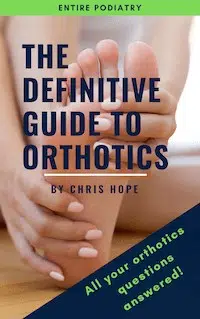Shockwave therapy is available at Entire Podiatry Brisbane CBD, Logan, North Lakes and Robina clinics.
What is shockwave and how does it work?
Shockwave therapy is a modern technology used for the treatment of sub-acute and chronic musculoskeletal pain. It is also known as Extracorporeal Shockwave Therapy (ESWT) or Extracorporeal Pulse Activation Therapy (EPAT) which is a non-invasive treatment option for tendon and ligament injuries.
“Extracorporeal” means outside of the body and “Pulse Activation” is a type of shockwave, also recognised as sound or pressure waves. This therapy works by the EPAT device sending acoustic waves into the affected area to encourage the body’s natural healing response.
This is a non-surgical and non-pharmaceutical treatment modality with no known side effects.
The injured tissue responds to the acoustic waves in various ways, which allow the affected area to heal in the following ways:
Improved blood flow to the area:
Adequate blood flow is vital for any injury to heal. The shockwaves actually cause micro-trauma to the small capillaries that supply the tendons and bones. As the body attempts to repair these capillaries it actually increases the blood supply to the area by stimulating new blood vessel growth.
Reversing chronic inflammation:
Our body produces an inflammatory response following an injury. Inflammation is required for the injury to heal, by kicking off a complex cellular process that leads to cell regeneration and repair. However, when the inflammation has been present for too long the process stops being effective.
Shockwave therapy is able to essentially ‘restart’ the inflammatory response in order to get the body to return to a functional inflammatory state that allows tissue healing.
Collagen production:
Collagen is a key component of our tendons and ligaments. Following an injury our body must produce enough collagen to repair the damage and form a strong and healthy tendon or ligament. Shockwave therapy stimulates collagen production.
Pain reduction:
Pain is a complex process that involves interactions between numerous chemical signals. One of the chemicals responsible for producing pain is known as “Substance P”. Shockwave therapy reduces the amount of Substance-P, which in turn reduces the pain levels.
Ultimately shockwave therapy produces a number of changes at a cellular level to the injury site. These cellular changes encourage and improve the body’s own healing response.
What is shockwave used for?
Shockwave therapy can be used for many different conditions across a range of professions, from musculoskeletal injuries to urology!
As podiatrists we have a focus on the lower limb. The conditions that we see and treat the most commonly using shockwave therapy are:
- Plantar fasciitis
- Achilles tendinopathy
- Shin splints
- Myofascial trigger points
Plantar fasciitis
Plantar fasciitis can be a debilitating injury affecting the heel or arch of the foot. Treatment typically involves a combination of stretches/strengthening, activity modification, anti-inflammatory measures as well as decreasing the load going through the fascia by correcting footwear, strapping the foot and orthotic therapy.
Shockwave therapy can be done in combination with these traditional treatment methods by speeding up the body’s regenerative healing process.
Many studies have been done on the use of shockwave therapy for the treatment of plantar fasciitis. 1-2 A study in 2008 by Gerdesmeyer et al. found shockwave therapy significantly improved pain, function and quality of life compared with placebo in patients with recalcitrant plantar fasciitis. It reduced pain by an average of 72% after three sessions at a 12 weeks follow-up.2
Achilles Tendinopathy
The treatment of Achilles tendinopathy can be notoriously difficult. Strict adherence to a strengthening and stretching program plus changes to footwear, avoiding aggravating activities and orthotic therapy are all required for successful treatment. However, some people still have minimal success with these traditional treatment approaches.
There is Level 1 evidence (the highest level of medical evidence) showing Shockwave to be effective for Achilles pain in the tendon itself and at the Achilles tendon attachment on the heel bone.
- For mid-portion tendinopathy a study published in 2012 by Rowe et al. found that only 56% of patients had complete recovery with eccentric exercise alone. Whereas 82 % of subjects had complete recovery at 4 months with a combination of shockwave therapy and eccentric exercise. 3
- For insertional Achilles tendinopathy a study by Weigerinck et al. in 2013 found shockwave therapy to be an effective treatment of insertional Achilles tendinopathy.
A study published in 2011 assessed patients with Achilles tendinopathy who were treated with shockwave therapy. They found that 75% of patients were very satisfied, 18% were satisfied and only 3% of patients founds that the therapy did not improve their condition. 93% of patients also said that they would choose shockwave as their first choice treatment.
A 6 months follow-up study found that the average pain (on a VAS 10 point scale; 0 being no pain and 10 being the worst pain) found that the patient’s morning pain decreased from a 7.2 pre-treatment to a 2.1 and pain during activity decreased from an 8.3 pre-treatment to a 3. 4
Medial Tibial Stress Syndrome (Shin Splints)
Shin splints can require long rest-periods away from sports in order to allow the inflamed soft tissue adequate time to recover. Traditional treatment includes a combination of rest, pain management, stretching and strengthening, changes to footwear and controlling poor biomechanics through the use of orthotics.
A study published in 2009 by Rompe et al. compared two groups of patients with chronic shin splints. One group was given a standard home treatment protocol and the other group was given this same protocol plus shockwave therapy. They found that 85% of patients who received the shockwave therapy were able to return to active sports compared to only 46% in the control group. 5
Myofascial Trigger Points
A trigger point is a tender nodule located in a taut band of muscles in the tissue, which affects not only the muscle where the trigger point is located, but also causes “referred pain” in tissues supplied by nerves.
In the lower limbs, trigger points are often found in the calf muscle. This can cause pain in the calf muscle at the sites of these trigger points but is also associated with Achilles tendinopathy and overuse of the muscles leading to shin splits.
Shockwave therapy is able to release these trigger points. The acoustic energy can break up the contracting muscle fibres of the trigger point, causing the muscle to loosen and relax.
What does Shockwave therapy feel like?
Shockwave therapy is quite a unique feeling. The intensity of the treatment depends on the area requiring treatment, the patient’s current pain levels and each individual’s tolerance.
It is normal and expected to feel some discomfort during the treatment. However, the treatment usually only takes around 15 minutes to complete so most people are able to tolerate this sensation.
Some people describe the feeling to be a ‘flicking’ sensation against the skin, whilst others describe as a ‘rattling’ sensation.
At Entire Podiatry we use the Chattanooga system. One of the benefits of this machine if that we can easily use a setting which will gradually increase the intensity of the treatment in order to maximise your comfort whist still giving the therapeutic benefit.
The practitioner has full control over the settings and can adjust this based on the patient’s feedback.
How many sessions are needed? And when can I expect to being feeling better?
We usually recommend 3 to 5 sessions at weekly intervals. Patients are evaluated at 12 weeks after the first treatment.
After the treatment is complete, some patients may note some immediate reduction in pain. This is one of the short-term effects of shockwave therapy due to the immediate reduction in the pain-promoting chemicals.
Keep in mind though as shockwave stimulates the body’s natural healing process it can take a number of weeks to see the best results.
The maximal therapeutic effect is felt about 12 weeks after the initial treatment.
Is shockwave safe?
Yes, shockwave therapy has been found to have very few, if any side effects. It has been approved by both the Therapeutics Goods Administration (TGA) in Australia and the Food and Drug Administration (FDA) in America.
Is shockwave suitable for everyone?
There are a few people for whom shockwave is not recommended.
Shockwave is most effective for chronic conditions. This means it is most suited to treat a musculoskeletal condition that has been present for longer than 5 weeks. We will not provide shockwave therapy on a very recent injury.
Patients who have a pacemaker, are pregnant or have a clotting condition or take medications that affect blood clotting should also avoid shockwave therapy.
We also do not provide shockwave therapy to those under the age of 18.
How much does Shockwave therapy cost and does my private health insurance cover any?
There is an additional fee for the shockwave therapy on top of the standard consultation fee. The price will vary depending on the number of areas requiring treatment. View our Entire Podiatry pricelist.
Many private health funds will cover a percentage of both the consultation and the shockwave fee.
Is this treatment available at every Entire Podiatry clinic?
This therapy is available at Entire Podiatry Brisbane CBD, North Lakes, Logan and Robina. Please contact Entire Podiatry on 1800-4-ENTIRE for information about the most convenient clinic location for your shockwave therapy.
References:
Chew KT. Comparison of Autologous Conditioned Plasma Injection, Extracorporeal Shockwave Therapy, and Conventional Treatment for Plantar Fasciitis: A Randomized Trial. nPM R. 2013 Aug 22.
Gerdesmeyer L, Frey C, Vester J, Maier M, Weil L Jr, Weil L Sr, Russlies M, Stienstra J, Scurran B, Fedder K, Diehl P, Lohrer H, Henne M, Gollwitzer H. Radial extracorporeal shock wave therapy is safe and effective in the treatment of chronic recalcitrant plantar fasciitis: results of a confirmatory randomized placebo-controlled multicenter study. Am J Sports Med. 2008 Nov;36(11):2100-9. doi: 10.1177/0363546508324176. Epub 2008 Oct 1. PMID: 18832341.
Rowe V, Hemmings S, Barton C, Malliaras P, Maffulli N, Morrissey D. Conservative management of midportion Achilles tendinopathy: a mixed methods study, integrating systematic review and clinical reasoning. Sports Med. 2012 Nov 1;42(11):941-67. doi: 10.1007/BF03262305. PMID: 23006143.
Wiegerinck JI, Kerkhoffs GM, van Sterkenburg MN, Sierevelt IN, van Dijk CN. Treatment for insertional Achilles tendinopathy: a systematic review. Knee Surg Sports Traumatol Arthrosc. 2013 Jun;21(6):1345-55. doi: 10.1007/s00167-012-2219-8. Epub 2012 Oct 6. PMID: 23052113.
Rompe JD, Cacchio A, Furia JP, Maffulli N. Low-energy extracorporeal shock wave therapy as a treatment for medial tibial stress syndrome. Am J Sports Med. 2010 Jan;38(1):125-32. doi: 10.1177/0363546509343804. Epub 2009 Sep 23. PMID: 19776340.





